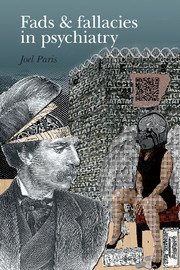3 - Psychiatry
from Part I - Origins
Published online by Cambridge University Press: 01 January 2018
Summary
Psychiatry could be more prone to fads than other specialties in medicine. I do not have the data to prove whether that is true. It is possible that I only see things this way because psychiatry is my specialty and I know the field well. However, the perception has been shared by some noted colleagues (Frances, 2009; Carlat, 2010), as well as by some well-informed outside observers (Horwitz, 2002).
If psychiatry is prone to fads, why should that be the case? One explanation is that mental illness is poorly understood. Although many other areas of medicine are equally mysterious, disorders of the mind carry a unique complexity and will take many decades to unravel. Another possibility is that mental disorders are particularly hard to treat. Objectively, this may not be so. As shown by Leucht et al (2012), effect sizes in psychiatry derived from meta-analyses compare favourably with those in other medical specialties. Nonetheless, not all patients do well, and there is something unique about mental suffering. This makes mental health practitioners keen to find remedies.
Finally, even if psychiatrists help a lot of patients, they do not have a good understanding of how their treatments work (Healy, 2002). If the mechanisms of mental illnesses are unknown, one cannot know either aetiology or pathogenesis, and develop logical interventions to break causal chains. In psychiatry, this makes the field vulnerable to people with bright ideas. And usually you cannot prove them wrong, at least not at first.
In this light, it should not be surprising that the history of 20th-century psychiatry was replete with theories and treatments that promised a great deal, but did not stand up to scrutiny. Each time a diagnostic fad or a treatment fad died out, a new one appeared. To shed light on the current state of psychiatry, it is instructive to go back in history to see how fads developed and disappeared.
I will illustrate this theme through examples drawn from two very different branches of psychiatry: psychoanalysis and psychosurgery. I will also discuss an effective treatment (electroconvulsive therapy) that temporarily morphed into a fad.
- Type
- Chapter
- Information
- Fads and Fallacies in Psychiatry , pp. 24 - 34Publisher: Royal College of PsychiatristsPrint publication year: 2013



